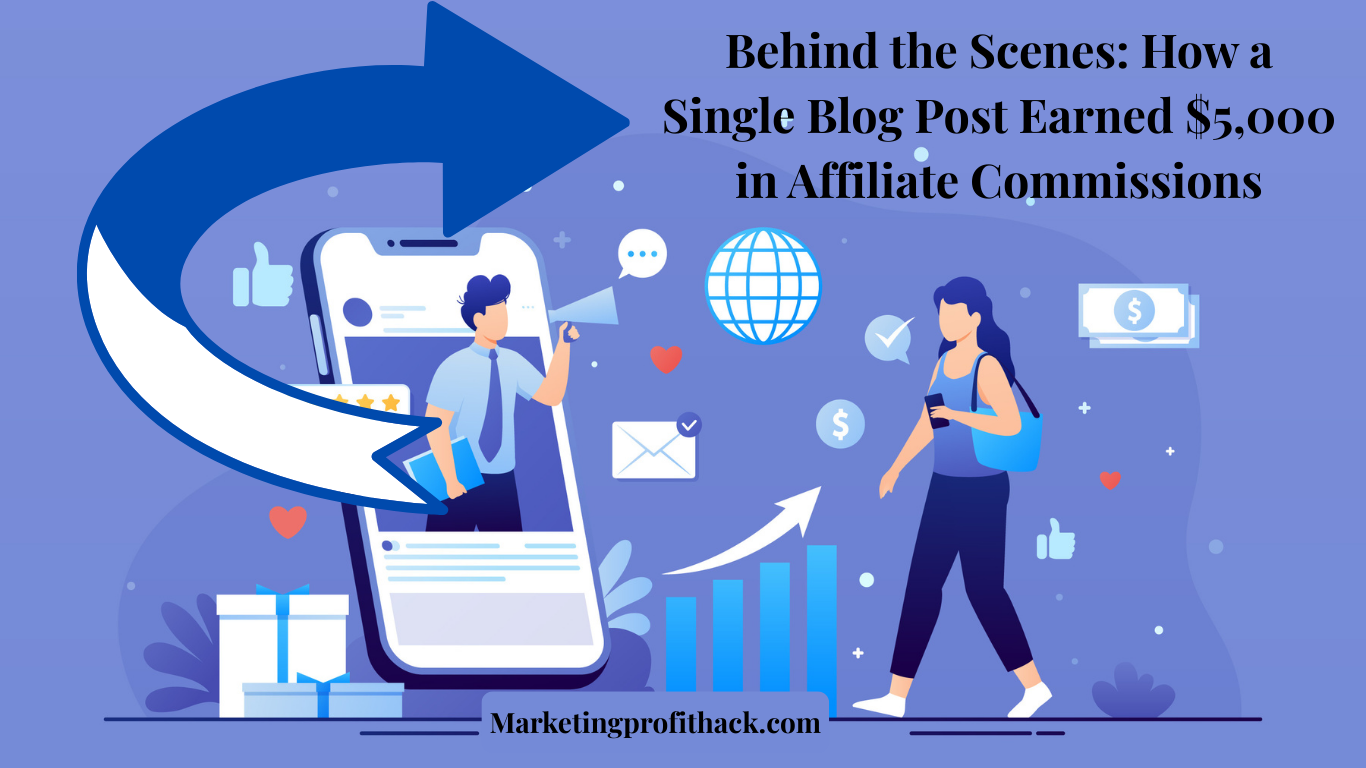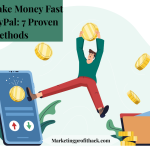Welcome to my article “Behind the Scenes: How a Single Blog Post Earned $5,000 in Affiliate Commissions“. They say blogging is dead—but my bank account strongly disagrees. While some folks are out here chasing the next shiny social media trend, I’m over here sipping coffee and watching one humble blog post rake in affiliate commissions like it’s got a side hustle of its own. Yup, just one post. No, this isn’t a clickbait story—unless you count affiliate links as bait (which… fair enough).
Let’s rewind. This post didn’t explode overnight or get shared by Elon Musk (sadly). It was born from strategy, research, a pinch of SEO fairy dust, and a whole lot of testing. In this blog, I’m pulling back the curtain to show you exactly how this one piece of content brought in over $5,000 in affiliate revenue—without needing 100,000 followers or a viral TikTok dance. From niche selection and keyword targeting to copy that converts, I’m sharing all the gritty details (no gatekeeping here).
Whether you’re just starting out in affiliate marketing or you’ve got a few blog posts collecting virtual dust, this behind-the-scenes breakdown will give you a real-life example of what works—and what you can apply to your own strategy. Oh, and if you’ve ever doubted the power of passive income… prepare to become a believer.
Let me know if you’d like a detailed outline for the rest of the blog too!
Proven Formula for $50-$100 Daily Income with 0 COST – Watch This FREE Video >>

🧠 Choosing the Right Topic: Why It All Starts with Strategy
Before you can make money from a blog post, you have to make sure someone actually wants to read it—and preferably, they want to read it with their wallets open. That’s why choosing the right topic isn’t just about following your passion (sorry, cat sweater reviews); it’s about combining search intent, buyer behavior, and smart keyword research into one glorious content cocktail.
Think of it this way: writing a blog post without strategy is like throwing a dart in the dark while blindfolded and dizzy. Sure, you might hit something, but odds are you’re just poking holes in your wall. You need a target—and that target is a topic with proven demand and monetization potential.
So how do you find a winning topic? Here’s what I did:
- I started by brainstorming questions and problems my audience was actively Googling.
- Then I turned to keyword research tools like Ubersuggest, Ahrefs, and even the good ol’ Google autocomplete.
- I filtered for long-tail keywords with decent search volume and low competition. Bonus points if the keyword screams buying intent—think: “best hosting for WordPress beginners” or “[product] review 2025.”
The magic phrase here is: buyer intent. If someone is searching for “best email marketing tools for small businesses,” they’re not looking for bedtime reading—they’re probably ready to swipe their credit card. That’s your cue.
In the case of the $5,000 blog post, the topic was laser-focused on a problem people were desperate to solve—and the affiliate product was the perfect solution. No sleazy sales tactics. Just helpful content meeting a real need.
Bottom line? The right topic is half the battle. Do your research, think like a buyer, and don’t just write what you think is interesting. Write what they are searching for—and are willing to spend money on.
Let me know if you’d like to move on to the next section: “Writing with Purpose: Structuring Content That Converts”!
Absolutely! Here’s an expanded version of “Writing with Purpose: Structuring Content That Converts”, keeping that informative tone with a sprinkle of humor:
✍️ Writing with Purpose: Structuring Content That Converts
Okay, so you’ve picked a winning topic. Congrats! But now comes the part where a lot of bloggers drop the ball—they start writing like they’re crafting a diary entry instead of a conversion machine. Remember: you’re not just writing to inform… you’re writing to convert. That means every sentence should have a job to do (no freeloading words allowed).
Let’s break down the secret sauce to a high-converting blog post structure:
🔥 1. Hook Them Fast
The intro should grab your reader like a Netflix cliffhanger. Lead with a relatable problem, sprinkle in some personality, and hint at the solution you’re about to deliver. You’ve got about 5 seconds to convince them not to click away—make it count.
📚 2. Deliver Value Like a Pro
Now it’s time to actually help people. Break your post into easy-to-skim sections using headers, bullets, bold text, and maybe even a cheeky GIF if it fits your brand. Give honest insights, clear solutions, and make them feel like you just saved their day. People don’t buy from robots—they buy from people who get them.
💰 3. Slide in the Affiliate Links (Smoothly!)
Here’s the golden rule: recommend, don’t push. We’re not used car salespeople. Place affiliate links where they naturally make sense—like after you explain why you love the product, how it helped you, or when you’re offering a solution. A simple “Here’s the tool I used” can go a long way.
Pro tip: use comparison tables, pros and cons lists, or product snapshots to make links more clickable. Bonus points for transparency—tell your readers it’s an affiliate link. Honesty builds trust, and trust builds commissions.
🧠 4. End With a Nudge, Not a Shove
Wrap it up with a solid conclusion that reinforces the main point and encourages action. Whether it’s clicking a link, signing up for a free trial, or just bookmarking the post—give them something to do before they wander off to watch cat videos.
Proven Formula for $50-$100 Daily Income with 0 COST – Watch This FREE Video >>
When your post is structured with purpose, it becomes more than just another blog on the internet. It becomes a 24/7 sales machine in disguise, working while you sleep. So write smart, write human, and for the love of conversions—give those affiliate links a fighting chance!
Want to dive into the next section? We can explore “Affiliate Link Placement: Subtle, Strategic, and Click-Worthy” next!
Of course! Here’s the expanded section for “Affiliate Link Placement: Subtle, Strategic, and Click-Worthy”, keeping the same informative vibe with a touch of humor:
🔗 Affiliate Link Placement: Subtle, Strategic, and Click-Worthy
Affiliate links are like seasoning—use just the right amount, and your content is delicious. Overdo it, and suddenly you’re the spammy guy at the internet party no one wants to sit next to. The secret? Strategic placement that feels natural, helpful, and impossible not to click.
Let’s get one thing straight: your blog post is not a sales page. It’s a helpful, engaging, value-packed piece of content that just happens to contain some well-placed links that can earn you money. The goal is to weave them in so smoothly your readers don’t feel sold to—they feel guided.
Here’s how to do it like a pro:
🧭 1. Context Is King
Don’t just drop a random “Click here for this amazing product!!!” in the middle of a sentence about your morning coffee. Instead, introduce your affiliate product as a natural part of the solution. Example: “When I switched to [Product Name], not only did my site load faster, but my stress levels dropped 20%—highly recommend.”
If it sounds like something you’d say to a friend over coffee, you’re on the right track.
👀 2. Place Links Where Eyes Naturally Go
Most readers skim, so put your best-performing affiliate links:
- Above the fold (early in the post, after a hook)
- In headers or subheadings (sparingly)
- Inside comparison tables or product boxes
- Next to a strong CTA (Call to Action)
You can even bold key sentences to draw attention—but don’t go full neon highlighter unless you’re aiming for early 2000s Myspace vibes.
🎯 3. Use Clear, Clickable Anchor Text
Avoid the dreaded “click here.” Instead, try:
- “Get 50% off with this tool I use”
- “See my full review of XYZ”
- “Try [Product Name] free for 14 days”
Be specific and action-oriented. Let readers know exactly what they’re getting when they click.
🕶️ 4. Cloak (or Not to Cloak?)
Some affiliate links look like they came from a robot factory—long, messy, and scary. Tools like Pretty Links or ThirstyAffiliates can “cloak” your URLs to make them prettier and more trustworthy. Just be transparent that it’s an affiliate link (you’ll stay on Google’s good side and build trust with your audience).
Remember: you’re not trying to trick anyone. You’re solving problems—and oh look, here’s a handy product that helps. It’s affiliate marketing, not Jedi mind tricks. When done right, your readers will click because they genuinely want to, not because they’re being nudged off a digital cliff.
Let me know if you want to keep going with the next section:
👉 “Promoting the Post: Getting Eyeballs on Your Content”
🚀 Promoting the Post: Getting Eyeballs on Your Content
You’ve crafted the perfect post. Your structure is tight, your affiliate links are in stealth mode, and your content is so good it could bring a tear to a digital marketer’s eye. Now what?
Well, my friend, if you just hit “publish” and wait for the money to roll in… you’re in for a long, quiet night. Like a tree falling in an empty forest, even the most brilliant blog post won’t earn a dime if no one sees it. Promotion isn’t optional—it’s half the battle.
Let’s talk about how to actually get eyeballs on that beautiful content of yours.
📲 1. Share It Like You Mean It (Everywhere)
Start with your own platforms—social media, email list, even that group chat with your three cousins who never read anything. Get the word out:
- Facebook Groups (related to your niche, not your grandma’s knitting club)
- Twitter/X and LinkedIn (if your content fits the vibe)
- Pinterest (yes, it still works wonders for certain niches!)
- Instagram Stories or Reels with a “swipe up” if you’ve got that privilege—or link in bio for us mortals.
Pro tip: Create multiple posts and rotate them. One post, one graphic, one tweet = not enough. Repurpose like a boss.
🧠 2. Use Email to Resurrect the Living Dead
If you’ve got an email list—even if it’s just 43 people and your dog’s burner account—send the post out. Keep the subject line snappy, tease the benefit, and link directly to the post.
Later? Resend it to people who didn’t open the first time. Most email tools let you do this with one click. Ninja move.
🔍 3. SEO Isn’t a Maybe—it’s a Must
SEO is the long game, but it pays off like compound interest. Make sure your post is optimized with:
- A juicy, keyword-rich headline
- Keyword-friendly subheadings
- An engaging meta description
- Alt-text on images
- Internal links to other helpful posts
It’s like giving Google a neon sign that says “Hey! Over here! This post is actually helpful!”
💬 4. Don’t Forget to Be Human
Engage in conversations where your content fits. That could mean:
- Answering questions on Quora
- Commenting on relevant Reddit threads
- Dropping value (and your link) in niche forums
- Collaborating with others in your niche for content swaps or shout-outs
The goal? Be helpful first. The link comes later.
Bottom line: writing the post is just the beginning. To turn it into a $5,000 machine, you need to put in the promotion work. Think of it like launching a rocket—you don’t want to fizzle on the launch pad because no one heard the countdown.
Proven Formula for $50-$100 Daily Income with 0 COST – Watch This FREE Video >>
Ready to wrap this up with the final section?
Let’s dive into 👉 “Tracking, Tweaking, and Scaling: Turning One Win Into Many.”
You got it! Here’s the final expanded section for “Tracking, Tweaking, and Scaling: What Happened After the Post Went Live”, keeping it insightful, actionable, and just the right amount of fun:
📈 Tracking, Tweaking, and Scaling: What Happened After the Post Went Live
So, the blog post is live, the world hasn’t ended, and—wait, is that… an affiliate commission email in your inbox? Cue happy dance. But don’t pop the champagne just yet. The real magic happens after you hit publish. This is where you go full nerd and dive into the data.
Because let’s be real: you didn’t write that post just to hear yourself type. You wrote it to convert. So now it’s time to track what’s working, tweak what isn’t, and scale like your blog’s life depends on it.
🕵️ 1. Spy on Your Stats (Like a Friendly Stalker)
Start with the basics:
- Google Analytics – check how many people are visiting, how long they’re staying, and whether they’re bouncing faster than a rubber ball.
- Heatmaps (like Hotjar or Crazy Egg) – see where people are clicking (and where they’re not).
- Affiliate Dashboards – track which links are getting clicked, how often, and what’s bringing in the cash.
Find patterns. Is one section converting like crazy? Is your call-to-action buried at the bottom and getting ignored? Let the data do the talking.
🔧 2. Tweak, Don’t Panic
Think of your post like a living thing—it evolves. If the traffic’s good but conversions are meh, test:
- A new headline
- A stronger call to action
- A more enticing affiliate offer
- Moving links higher in the post
Small changes can lead to big results. You’re not starting from scratch—you’re just giving your post a little makeover (no glitter needed).
🚀 3. Scale What’s Working
Here’s the fun part: once you find the secret sauce, make more of it.
- Turn the blog post into a YouTube video
- Create an email series around the same topic
- Build a freebie or lead magnet and drive traffic to it via the post
- Use paid ads to get more eyeballs if the ROI is there
Also: replicate the strategy! If one blog post brought in $5K, imagine what five could do. Same blueprint, new topics, repeat.
In the end, this one post wasn’t just a lucky win—it was proof of concept. A test that worked. And once you know what works, it’s not a fluke—it’s a formula. That’s how you build momentum, income, and yes, maybe even a full-time business around affiliate marketing.
So keep tracking, keep tweaking, and don’t be afraid to scale the heck out of your success. That $5,000 post? It might just be the start.
Let me know if you’d like help wrapping the article up with a strong conclusion or crafting a killer title + meta description combo!
Absolutely! Here’s a fun, informative wrap-up for the Conclusion section of your blog post, “Behind the Scenes: How a Single Blog Post Earned $5,000 in Affiliate Commissions.” The tone stays true to your style—clear, helpful, and with a touch of humor.
🏁 Conclusion: One Blog Post, Big Results
So there you have it—the not-so-secret recipe behind a single blog post pulling in $5,000 in affiliate commissions. And no, it didn’t happen because of some mysterious internet sorcery or because I slipped Google a $20 bill (I tried—Google wasn’t impressed).
It happened because of strategy. From picking a high-intent topic, to writing content with purpose, to placing affiliate links like a digital ninja, and promoting it like I was running for office—every piece of the puzzle mattered. And once it worked? I didn’t just sit there polishing my commission trophy—I tracked it, tweaked it, and started scaling the success.
Here’s the big takeaway:
💡 Affiliate success doesn’t come from luck. It comes from building something valuable, sharing it with the right people, and optimizing like your income depends on it—because it kind of does.
Will every blog post be a $5K banger? Probably not. But when you follow a smart, repeatable system, you’re not gambling—you’re planting seeds. And with the right nurturing, some of them will grow into commission-generating trees that keep giving long after you’ve moved on to your next big idea (or Netflix binge).
Now it’s your turn—grab that laptop, pick a killer topic, and start writing like your affiliate paycheck is on the line.
Because guess what?
It is. 😉
Let me know if you’d like a call-to-action section next or a catchy meta description to go with this SEO-optimized post!
Proven Formula for $50-$100 Daily Income with 0 COST – Watch This FREE Video >>
Thank you so much for reading through my article on ‘ Behind the Scenes: How a Single Blog Post Earned $5,000 in Affiliate Commissions’ I hope you found it helpful and informative. Stay tuned for more insights in my next article—see you soon!”










